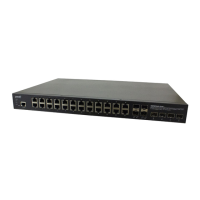Lantronix SISPM1040-xxxx-L3 Web User Guide
33856 Rev. A https://www.lantronix.com/ 210
RADIUS-Assigned VLAN Enabled: RADIUS-assigned VLAN provides a means to centrally control the VLAN on
which a successfully authenticated supplicant is placed on the switch. Incoming traffic will be classified to and
switched on the RADIUS-assigned VLAN. The RADIUS server must be configured to transmit special RADIUS
attributes to take advantage of this feature (see RADIUS-Assigned VLAN Enabled below for a detailed
description).
The "RADIUS-Assigned VLAN Enabled" checkbox provides a quick way to globally enable/disable RADIUS-
server assigned VLAN functionality. When checked, the individual ports' ditto setting determines whether
RADIUS-assigned VLAN is enabled on that port. When unchecked, RADIUS-server assigned VLAN is disabled
on all ports.
Guest VLAN Enabled: A Guest VLAN is a special VLAN - typically with limited network access - on which
802.1X-unaware clients are placed after a network administrator-defined timeout. The switch follows a set of rules
for entering and leaving the Guest VLAN as listed below.
The "Guest VLAN Enabled" checkbox provides a quick way to globally enable/disable Guest VLAN functionality.
When checked, the individual ports' ditto setting determines whether the port can be moved into Guest VLAN.
When unchecked, the ability to move to the Guest VLAN is disabled on all ports.
Guest VLAN ID: This is the value that a port's Port VLAN ID is set to if a port is moved into the Guest VLAN. It is
only changeable if the Guest VLAN option is globally enabled. Valid values are in the range [1; 4095].
Max. Reauth. Count: The number of times the switch transmits an EAPOL Request Identity frame without
response before considering entering the Guest VLAN is adjusted with this setting. The value can only be
changed if the Guest VLAN option is globally enabled. Valid values are in the range [1; 255].
Allow Guest VLAN if EAPOL Seen: The switch remembers if an EAPOL frame has been received on the port for
the life-time of the port. Once the switch considers whether to enter the Guest VLAN, it will first check if this option
is enabled or disabled. If disabled (unchecked; default), the switch will only enter the Guest VLAN if an EAPOL
frame has not been received on the port for the life-time of the port. If enabled (checked), the switch will consider
entering the Guest VLAN even if an EAPOL frame has been received on the port for the life-time of the port.
The value can only be changed if the Guest VLAN option is globally enabled.
Port Configuration: The table has one row for each port on the switch and several columns:
Port: The port number for which the configuration below applies.
Admin State: If 802.1X is globally enabled, this selection controls the port's authentication mode. The following
modes are available:
Force Authorized: In this mode, the switch will send one EAPOL Success frame when the port link
comes up, and any client on the port will be allowed network access without authentication.
Force Unauthorized: In this mode, the switch will send one EAPOL Failure frame when the port link
comes up, and any client on the port will be disallowed network access.
Port-based 802.1X: In the 802.1X-world, the user is called the supplicant, the switch is the authenticator,
and the RADIUS server is the authentication server. The authenticator acts as the man-in-the-middle,
forwarding requests and responses between the supplicant and the authentication server. Frames sent
between the supplicant and the switch are special 802.1X frames, known as EAPOL (EAP Over LANs)
frames. EAPOL frames encapsulate EAP PDUs (RFC3748). Frames sent between the switch and the
RADIUS server are RADIUS packets. RADIUS packets also encapsulate EAP PDUs together with other
attributes like the switch's IP address, name, and the supplicant's port number on the switch. EAP is very
flexible, in that it allows for different authentication methods, like MD5-Challenge, PEAP, and TLS. The
important thing is that the authenticator (the switch) doesn't need to know which authentication method
the supplicant and the authentication server are using, or how many information exchange frames are
needed for a particular method. The switch simply encapsulates the EAP part of the frame into the
relevant type (EAPOL or RADIUS) and forwards it.
When authentication is complete, the RADIUS server sends a special packet containing a success or
failure indication. Besides forwarding this decision to the supplicant, the switch uses it to open up or block
traffic on the switch port connected to the supplicant.

